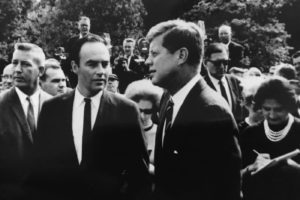David M. Stone, for The Inquirer: “Harris Wofford followed the question where it leads”
Harris Wofford followed the question where it leads
by David M. Stone, for The Inquirer
January 28, 2019
The admiring obituaries of Harris Wofford’s extraordinary life suggest why such a diversity of people around the country and the world have their own special stories to tell about him.
Mine begins in a basement campaign office on Chestnut Street in 1986 during Bob Casey’s successful gubernatorial race. Casey asked his onetime Washington law-firm friend to serve as Democratic State Party chair, a seemingly unconventional role for a former college president and civil rights pioneer. Five years later, after the tragedy of John Heinz’s plane crash over Lower Merion when the governor named him to the vacant Senate seat, I was one of several Casey administration colleagues, including his son Dan, who joined Harris’ campaign and new Senate staff. His landslide upset that November was one more unlikely chapter in a life driven by his Socratic maxim to “follow the question where it leads.”
Harris’ populist appeal was certainly not in performance value; he had no interest or capacity for playing any inauthentic role. It was rooted in big ideas about the common good. Fact is, he was blithely unaware of most popular culture, even close to home. I once suggested he use an admittedly lame line that Republican claims of tax cuts being “fiscally responsible” were “like calling a cheesesteak a heart-smart meal.” Despite being a Philadelphian for more than two decades, Harris’ surprised reaction was ‘steak … with cheese? Sounds awful.”
What was so distinctive about Harris’ life is how he blended traditional accomplishment with unconventional risk-taking: thought to be the first white man to attend Howard Law School when it was a center of the civil rights litigation that led to the Brown v. Board of Education; an American who went to India with his new wife Clare to cowrite a book about Gandhi and nonviolent civil disobedience; a gentile who went with Clare to live on a kibbutz in Israel during its founding days as an experiment in social democracy; and later, presumably the last man to serve as president of Bryn Mawr College, just as the women’s movement became a vital force in our society. Finally, of course, a man who had a loving, half-century marriage to a strong, accomplished woman, yet late in life began a second great love and marriage with a man, which he so movingly recounted in the New York Times.
Everyone who knew Harris and Clare, from their meeting as fellow leaders of student federalism in the mid-1940s until her death in early 1996, knows just how central she had been to his life, not only as parents of three successful children who were so much a part of their shared adventures, but as a candid partner, editor, and critic. I certainly knew that from the decade we had worked together by then. But I learned it most powerfully when Harris asked us to find a recording of the classic “Anniversary Song” — also known as “Oh How We Danced” — for Clare’s memorial service to be held at Bryn Mawr.
After I played a few moments of the song for him at home, Harris’ grief welled into deep sobs, and we hugged tightly for what I think was the first time ever. The unspoken intensity of feeling he conveyed made it clear what Clare meant to him, and just how true he was to his own heart in refusing to draw lines about the nature of gender and romantic love. I will never forget that moment, even as I was so glad years later to join his many friends and family in celebrating the great new happiness Harris found with Matthew Charlton.
Like so many who knew him, I also will laugh. Especially when I remember how, a few weeks after the disappointing 1994 reelection loss, Harris left an excited voice message that he and Clare had finally gotten to see Forrest Gump and could now fully appreciate a “Harris Gump” parody video we had produced a few months earlier for a political comedy night. Back when we shot the bus stop bench scene outside the Capitol, Harris obviously couldn’t model Tom Hanks’ performance. But he owned a light summer suit and, given his family’s deep southern roots, he pulled off the accent just fine.
Here’s the critical point about what really made the parody work: We didn’t need special effects to put this “Harris Gump” in the archival images of marching with Dr. King from Selma, or helping JFK launch the Peace Corps in the White House Rose Garden. That was the real Harris Wofford in the picture — not a passive, accidental character in American history, but an active, purposeful participant. And I’m just one of the many who will always feel proud to have helped follow the questions he asked during such a remarkable life of service to his state, his country, and the world.
•
David M. Stone was communications director to Gov. Robert P. Casey and Senator Harris Wofford.

No comments yet.
Add your comment